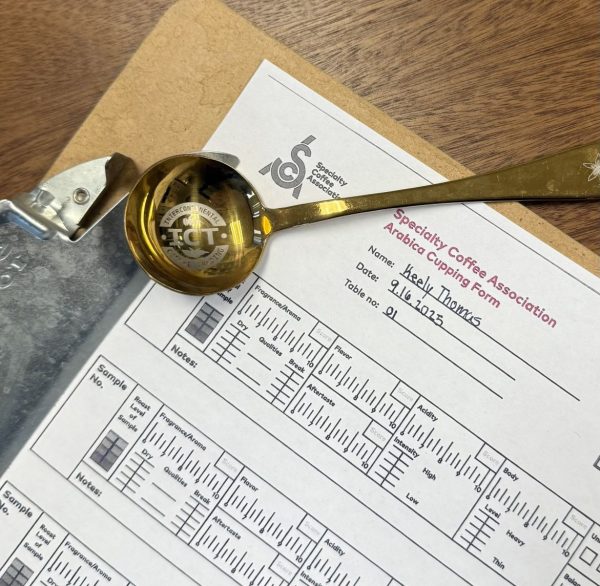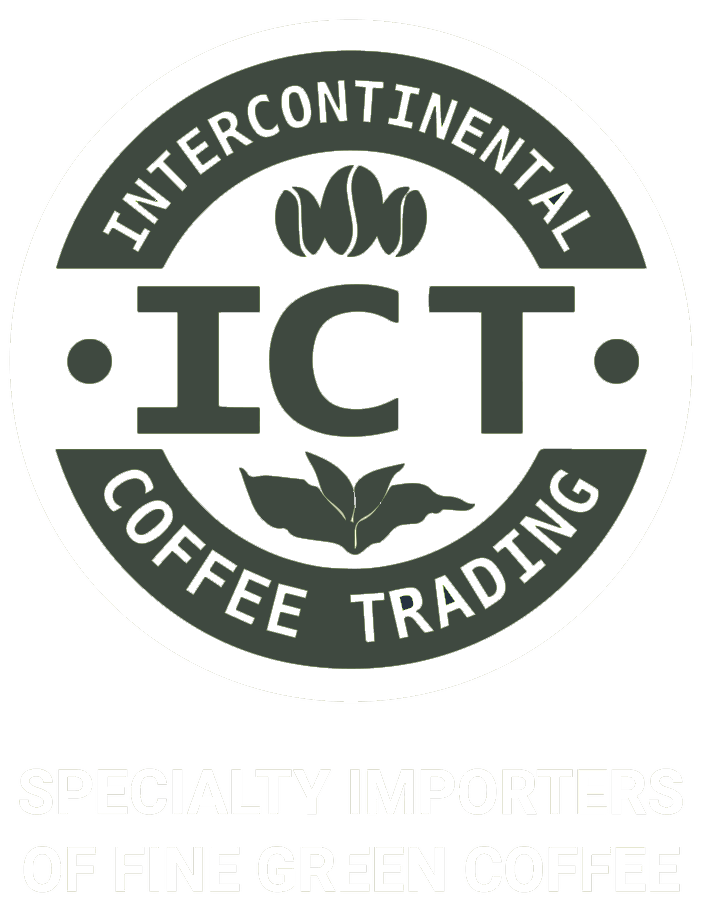
The coffee industry is evolving how we evaluate quality, and as your green coffee importing partner, we want you to understand what’s changing and how it affects your purchasing decisions. The Specialty Coffee Association recently introduced a new evaluation system called Coffee Value Assessment (CVA) that works alongside traditional Q grading to give you better information about the coffee you buy.
What You’ve Been Using: Q Grading Explained
For years, Q grading has been the industry standard – think of it as coffee’s report card with a score out of 100 points.
How Q Grading Works
The basics: Trained professionals evaluate coffee on 10 different characteristics and assign points for each. Coffees scoring 80+ points qualify as “specialty grade.”
What gets scored:
- Fragrance and aroma: How the coffee smells dry and wet
- Flavor: The taste characteristics you experience while drinking
- Aftertaste: How long flavors linger after swallowing
- Acidity: The bright, lively quality in coffee
- Body: How heavy or light the coffee feels in your mouth
- Balance: How well all the elements work together
- Uniformity: Whether all the cups of the same coffee taste consistent
- Clean cup: The absence of off-flavors or defects that distract from coffee quality
- Sweetness: The natural sugar-like flavor
- Overall impression: The holistic assessment of coffee quality
Why Q Grading Has Been Valuable
Clear standards: The 80-point threshold gives everyone a common definition of specialty coffee.
Easy communication: A score of 82 means the same thing whether you’re in New York or Guatemala.
Trade efficiency: Buyers and sellers can quickly assess and compare coffees using numerical scores.
The Problem with Scores Alone
While Q grading works well for basic quality control, it has limitations that have become more apparent as the coffee market has evolved.
One-size-fits-all thinking: A coffee that scores 84 isn’t necessarily better than one that scores 82 for your specific needs.
Missing the full picture: A score doesn’t tell you if a coffee will work well for espresso, pour-over, or your customer base.
Limited context: You get a number, but not the story behind what makes that coffee unique or valuable.
The New Tool: Coffee Value Assessment (CVA)
CVA doesn’t replace Q grading – it expands your evaluation toolkit. Instead of just asking “Is this coffee good?”, CVA asks three more specific questions:
- What does this coffee taste like? (Descriptive Assessment)
- Who will like this coffee? (Affective Assessment)
- What else makes this coffee valuable? (Extrinsic Assessment)
Component 1: Descriptive Assessment (What You Taste)
- What it does: Describes coffee characteristics without judging them as good or bad.
- How it helps you: You get specific tasting notes like “bright citrus acidity with chocolate finish” instead of just a number.
- Business impact: Better menu descriptions, more accurate customer communication, and clearer understanding of how coffee will perform in different brewing methods.
Component 2: Affective Assessment (Who Likes It)
- What it does: Measures how much different groups of people enjoy the coffee.
- How it helps you: Predicts market reception based on your target customers’ preferences.
- Business impact: Better inventory decisions, more successful product launches, and reduced risk of buying coffee that won’t sell.
Component 3: Extrinsic Assessment (The Full Story)
- What it does: Evaluates non-taste factors that add value to coffee.
- How it helps you: Understand sustainability credentials, unique processing methods, producer stories, and certifications.
- Business impact: Premium positioning opportunities, compelling marketing stories, and alignment with customer values.
Side-by-Side Comparison: What This Means for Your Business
Information Depth
Q Grading: “This coffee scored 85 points.” CVA: “This coffee has bright acidity and chocolate notes, appeals to customers who like balanced profiles, and comes from a carbon-neutral farm using innovative processing.”
Purchasing Decisions
Q Grading: Buy high-scoring coffees and hope they work for your needs. CVA: Buy coffees that match your specific menu goals, customer preferences, and brand values.
Customer Communication
Q Grading: “This is an 87-point coffee.” CVA: “This coffee offers bright citrus notes with a smooth chocolate finish, perfect for customers who enjoy vibrant, balanced cups. It’s also produced using sustainable farming practices.”
Inventory Strategy
Q Grading: Focus on highest scores within budget. CVA: Select coffees based on predicted market performance and comprehensive value factors.
How ICT Uses Both Systems for Your Benefit
We implement both Q grading and CVA because each system provides valuable but different information for your business decisions.
Q Grading Continues to Provide
- Industry standards: Maintains compatibility with existing trading systems and quality benchmarks.
- Quick assessment: Efficient quality screening for large volumes of coffee.
- Certification support: Meets requirements for various specialty coffee certifications and programs.
CVA Adds Strategic Value
- Detailed sensory profiles: Comprehensive tasting notes that support menu development and customer education.
- Market alignment data: Preference information that helps predict sales success.
- Complete value assessment: Documentation of sustainability, uniqueness, and story elements that drive modern purchasing decisions.
Practical Benefits for Your Coffee Program
Better Menu Development
Use descriptive assessment data to create accurate, compelling menu descriptions that help customers choose coffees they’ll enjoy.
Smarter Inventory Decisions
Combine traditional quality scores with market preference data to select coffees that will sell to your customer base.
Enhanced Customer Education
Move beyond “this is good coffee” to specific descriptions that build appreciation and justify premium pricing.
Strategic Sourcing
Consider the complete value package – not just cup quality, but also sustainability, uniqueness, and story elements that differentiate your offerings.
Reduced Risk
Better prediction of coffee performance based on comprehensive evaluation rather than single scores alone.
What This Transition Means
For your business: Access to more detailed, actionable information that supports better purchasing decisions and customer communication.
For the industry: Recognition that coffee value includes multiple factors beyond traditional quality metrics.
For producers: Expanded opportunities for recognition and premium pricing based on innovation, sustainability, and unique characteristics.
Making the Most of Both Systems
Use Q Grading For
- Basic quality assurance and industry standard compliance
- Quick quality screening and comparison
- Meeting certification and trading requirements
Use CVA For
- Strategic sourcing decisions aligned with your business goals
- Menu development and customer communication
- Understanding complete value proposition beyond cup quality
- Predicting market reception and sales performance
The Future of Coffee Evaluation
This isn’t about choosing sides – it’s about having better tools. Q grading provides the foundation of quality standards that the industry needs, while CVA adds the detailed information that modern coffee businesses require for strategic decision-making.
The trend: More comprehensive evaluation that recognizes coffee’s complexity and diverse value factors.
Your advantage: Access to both evaluation systems means better information for smarter purchasing decisions.
Why Partner with ICT
As your green coffee importing partner, we provide comprehensive quality information using both Q grading and CVA protocols. This dual approach ensures you have access to:
- Industry-standard quality verification through Q grading protocols
- Strategic sourcing information through comprehensive CVA assessment
- Detailed documentation that supports menu development and customer communication
- Market-relevant evaluation that aligns with your business objectives and customer preferences
Our experience with both systems means you get the best of both worlds: proven quality standards plus expanded evaluation capabilities that support modern coffee business success.
Key Takeaways
- CVA complements, doesn’t replace Q grading – you get more information, not different information
- Better purchasing decisions come from understanding both quality scores and comprehensive value factors
- Customer communication improves with detailed sensory descriptions and compelling stories
- Business strategy benefits from market preference data and complete value assessment
- Industry evolution toward more sophisticated, comprehensive coffee evaluation supports better outcomes for everyone
Ready to navigate the industry transition with confidence? Contact ICT to learn how our expertise in both Q grading and CVA protocols ensures you have the quality information you need, regardless of which evaluation system your coffee has undergone.
